“We need a reliable wireless network”
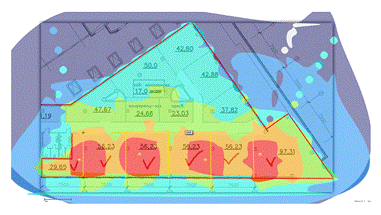
Recently, not just requests “count me N access points and a controller” come to our company more often, but already “we need a reliable wireless network in which users can use their own gadgets in their work”. Today we will tell you what we are doing and what tools we use in such cases.
Receiving such a request, we begin to ask the client questions that help to understand his task. Summarizing the results, we made a list of the main criteria that must be met by a “good” and reliable wireless network:
- ensuring high speed on the radio channel;
- coverage of a given space;
- possibility of simultaneous operation of the Nth number of clients;
- the ability to create a guest access and a working network with different levels of security, using only the functionality of the controller;
- the ability to filter traffic, assign policies and ensure wireless access security by means of the controller;
- ease of setting up this solution, i.e. on their own without the involvement of third-party specialists;
- the possibility of obtaining a guarantee of efficiency - the test, or demonstration, and preferably in the field;
- Of course, an interesting price.
In this post we will focus on the first three points. The choice of equipment, the number of equipment and its location directly affects the reliability of the wireless network at the physical level. That is why we recommend to carry out the network design stage before the project implementation.
We have already partially written about the remaining points in the previous post and, most likely, we will write more in the following.
')
Real customer task
Objective: to organize a wireless network in the office, consisting of 6 rooms located on the same side of the building and on the same floor.
Available: room layout, taken most likely from the fire evacuation plan. The red check marks indicate the target rooms.
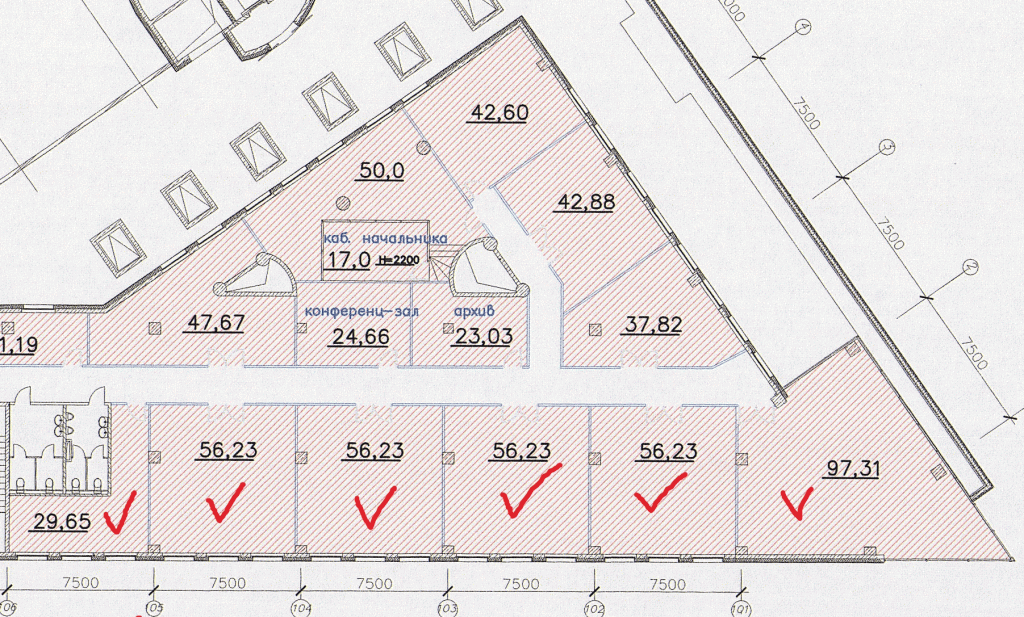
There is a lot of software to calculate the coverage area, but we prefer to use the original program developed by Aruba Networks - VisualRF Plan. Aruba is now the most technologically advanced developer of Wi-Fi solutions (in our opinion and the opinion of Gartner).
This program is available for download from the vendor's site if you have an account. There is also an online version based on Google maps for the design of coverage by the street / exterior network.
We load this plan into the program with an indication of the scale and begin to mark the location and type of walls on it with the mouse. Four wall options are available in this program:
- Concrete - from concrete;
- Cubicle - "booths", office partitions;
- Drywall - drywall;
- Glass - from glass.

In our case, red marked concrete walls, yellow - from drywall, which corresponds to the realities of our premises. We mark the area that needs to be covered with a wireless network (in gray on the diagram).
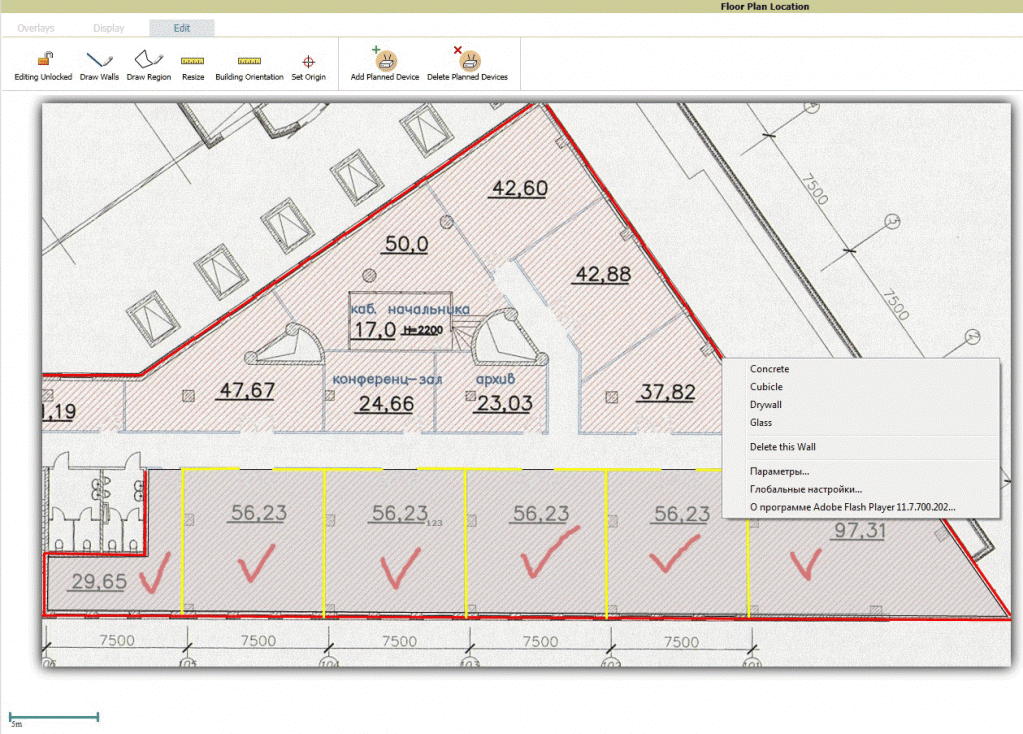
Select the area for planning and launch a dialog box in which you need to set the parameters for access points and the distribution of subscribers between them (maximum number of users, speed and number of users per channel).
In our case, we assign:
- The minimum speed of 90Mbps per user;
- Only 40 users, but not more than 5 per channel;
- The power of the transmitters is set to average so as not to jam neighboring offices;
- Determine the parameters of the space (environment): we set up offices-giprok;
- The point type is defined as AP-105 for the ability to support customers operating at 5 GHz (where, by the way, the radio is less loaded).
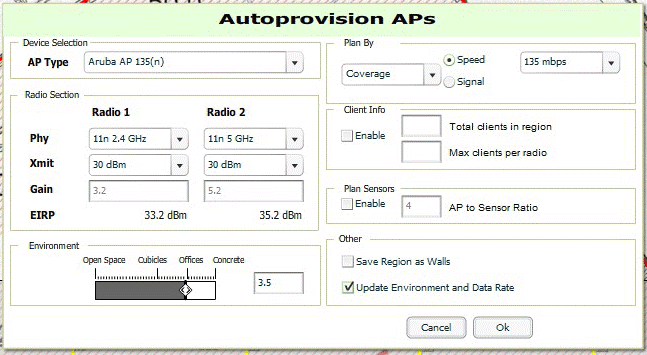
Access points Aruba Networks
Here it is necessary to make a small digression about the Aruba access points. Now in the model line Aruba there is a large line of access points:
"Standard" access points:
AP-68 is a single radio module, the frequency range is only 2.4 GHz, the aggregate speed is up to 150 Mbit / s, intended for rooms with a low subscriber density.
AP-93H - one radio module, 2x2 MIMO technology, can operate in the 2.4 GHz or 5 GHz range, the aggregate speed of up to 300 Mbit / s, has 4 Ethernet ports, and allows the development of cable infrastructure.
AP-93 - one radio module, 2x2 MIMO technology, can work in the 2.4 GHz or 5 GHz range, the aggregate speed of up to 300 Mbit / s, perfectly suited for offices and rooms with low density.
AP-105 - two radio modules, 2x2 MIMO technology, supports simultaneous operation on the 2.4GHz and 5GHz bands, and allows you to organize a wireless network in rooms where customers with different types of radio modules are concentrated.
AP-135 - two radio modules, 3x3 MIMO technology, contains two 10/100 / 1000BASE-T ports, an aggregate speed of up to 450 Mbit / s, provides high performance and speed even in bad radio environments.
Access Points for the organization of a remote workplace
Very good in the case when, for example, an employee is on a business trip.
RAP-2WG - only works in 2.4-GHz with a maximum speed of 54 Mbps, the size of a pack of cigarettes - perfect for taking on the road.
RAP-3WN - one radio module, 2x2 MIMO technology, works in the 2.4GHz band, supports the Instant mode, there is a USB port - allows you to connect a 3G / 4G modem, suitable for organizing a remote office.
RAP-5WN - one radio module, 3x3 MIMO technology, can work in the 2.4GHz or 5GHz range, the aggregate speed of up to 300Mbps, has 4 copper ports and a USB port - allows you to connect a 3G / 4G modem.
RAP-100 Series - two radio modules, 2x2 MIMO technology, supports simultaneous operation on the 2.4GHz and 5GHz bands, it is possible to connect an external antenna, there is a USB port - it allows you to connect a 3G / 4G modem.
The following algorithm can help determine the type of access points:

I note that according to statistical information, the percentage of devices that support operation at 2.4 GHz is much more than the percentage of devices operating at 5 GHz. According to some data, the ratio is about 67% to 33%. It makes sense that two-channel access points make sense to choose if you have or plan to have compatible devices.
The need for an external antenna can be determined by the specific geometry of the room when, for example, you want to send a signal to a narrow long corridor. In some cases, the choice between an internal or external antenna can be a matter of client taste.
Option number 1: AP-105 on average power
Let's return to this picture:

Select the type of point AP-105 and press the "OK" button. Based on the specified parameters, we obtain the following image:
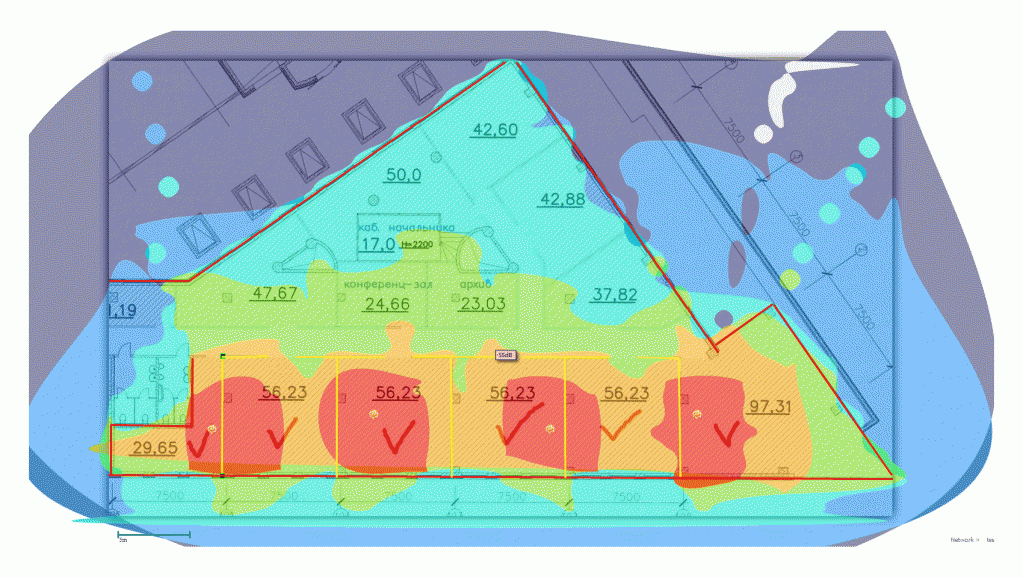
The resulting scheme reflects the radio frequency coverage of a given area in which the colored areas correspond to the following values:
- Red - signal level: -45 dB;
- Orange - signal level: -55db;
- Lime: -65db, etc.
If you are in the above three areas, you can work comfortably. To implement this, the program proposed to install four access points.
Option number 2: AP-135 to the maximum
Consider an alternative with a more powerful top access point AP-135 and a maximum power (30 dbm):
- 40 users, maximum 10 per channel;
- minimum speed of 90Mbps;
- we set the maximum power of each transmitter;
- access point select AP-135 (high density of users).
We get:
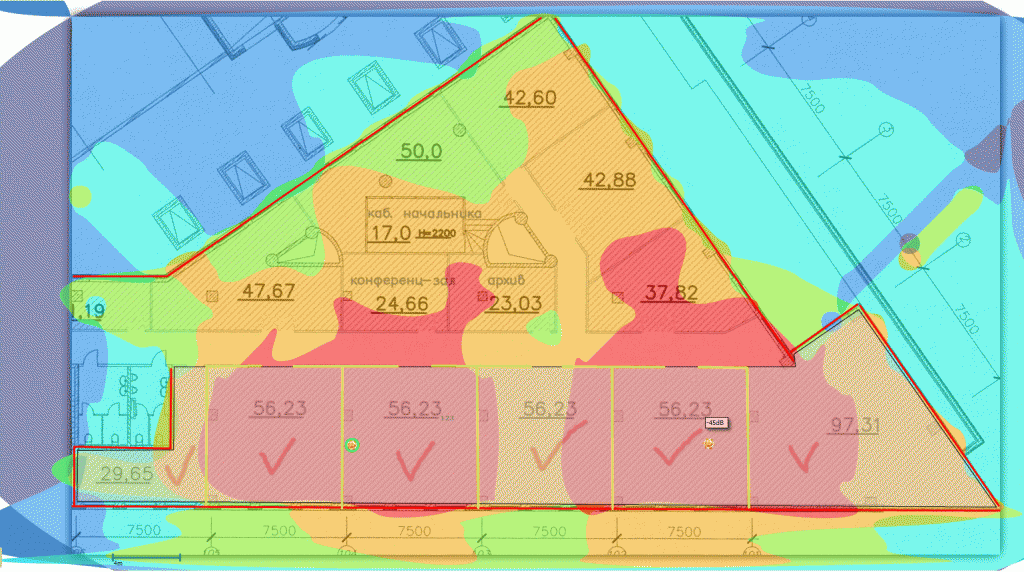
We see that two AP-135 access points at maximum power should cope with the task no worse than four AP-105 at average power. However, there is a nuance.
Conclusions and results
There are various ways to design a future wireless network - different manufacturers, different models, different numbers of points, etc. Software helps to conveniently evaluate various options and make a reasoned choice in favor of one of them. However, there are nuances that also need to be considered.
Firstly, the price for AP-135 is one and a half times higher in comparison with AP-105 and, acquiring two top access points, instead of four smaller ones, the cost advantage will be less than twice: 1.5x * 2 = 3x 4x.
Secondly, setting the maximum transmitter power at the access point in some cases may not solve the attenuation problem. Considering that there is still a transmitter on the end device, which must also “penetrate” all obstacles.
If you have premises on different floors, then the points exposed to the maximum will jam each other - as is well known in the 2.4 range, there are only 3 non-intersecting channels. Even if your office is located just on one floor, then you will begin to "turn off" your neighbors.
In this article, we gave a real example of the calculation of the project to provide an office with a wireless network. We usually offer the next stage, the customer agrees, and we carry out field testing of the selected equipment of its territory. For these purposes, a demo fund Aruba Networks has been formed in our Competence Center .
Successful and reliable operation of your Wi-Fi!
Source: https://habr.com/ru/post/182734/
All Articles